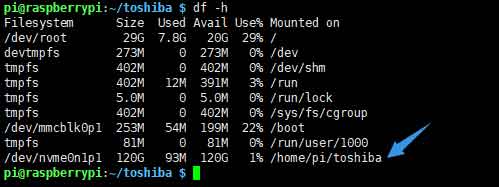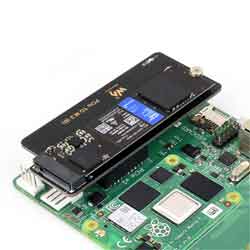- sales/support
Google Chat: zj734465502@gmail.com
- sales
+86-0755-88291180
- sales01
sales@spotpear.com
- sales02
dragon_manager@163.com
- support
tech-support@spotpear.com
- CEO-Complaints
zhoujie@spotpear.com
- sales/support
WhatsApp:13246739196
PCIe TO M.2 (B) Tutorial
Product Introduction
PCIe TO M.2 (A) is a PCI-E to M.2 adapter card used for upgrading hard drives SSD solid-state drive cards, and supports CM4
Characteristic
- Supports NVMe protocol M.2 interface hard disk protocol, high-speed read and write, high work efficiency
- Only supports CM4 expansion board
- Support Raspberry Pi Compute Module 4
- Compatible with M.2 hard drives of different sizes
- On board work indicator light, the LED stays on when powered on and flashes during reading and writing, indicating the clear working status at a glance
Instructions for use
Tutorial on mounting a hard drive to CM4
Format Hard Disk
- Insert the hard drive into the corresponding position of the PCI-E to M.2 adapter card and secure it with the screws in the screw pack.
- After powering on and starting, perform lspci to check the PCIE device

- Execute sudo mkfs. ext4/dev/nvme0n1p1 to format the device (mkfs. Then press tab to see many different suffix names, which are the format you want to format)
Wait for a moment, when done appears, it means that the formatting has been completed.



Mount
Create mounting directory
sudo mkdir toshiba
Mount device
sudo mount /dev/nvme0n1p1 ./toshiba
Check disk status
df -h
Mount hard drive
- Create a new directory as the disk mount point
sudo mkdir /home/pi/toshiba
- Execute the following command to mount the hard drive
sudo mount /dev/nvme0n1p1 /home/pi/toshiba
- Create a new directory as the disk mount point
Execute again
df -h
You can see the hard drive we inserted and related information, indicating that the hard drive has been successfully mounted

- For different hard drives, their names may vary. Here, nvme0n1p1 is displayed. Please refer to the hard drive you inserted.
literacy test
Enter the directory of the mounted disk
cd /home/pi/toshiba
- free memory
sudo sh -c "sync && echo 3 > /proc/sys/vm/drop_caches"
- Copy Raspberry Pi Memory Content to Hard Drive (Read)
sudo dd if=/dev/zero of=./test_write count=2000 bs=1024k

- Copy hard drive content to Raspberry Pi memory (write)
sudo dd if=./test_write of=/dev/null count=2000 bs=1024k
- Note: Raspberry pie is more affected by different cards and different environmental testing effects
Enter the directory of the mounted disk
cd /home/pi/toshiba
- free memory
sudo sh -c "sync && echo 3 > /proc/sys/vm/drop_caches"
- Copy Raspberry Pi Memory Content to Hard Drive (Read)
sudo dd if=/dev/zero of=./test_write count=2000 bs=1024k

- Copy hard drive content to Raspberry Pi memory (write)
TAG:
ESP32 H2 ESP32-H2-Zero MINI Development Board For BLE/Zigbee/Thread
Arducam
ESP32-S3 Relay 6-Channel IOT WiFi Bluetooth RS485 Pico Protection Circuits
Raspberry Pi CM5 Mini Base IO Board NANO B Development For Compute Module 5
LuckFox Pico Camera
Raspberry Pi Autofocus Camera
Raspberry Pi 3 LCD HAT
Raspberry Pi RP2040 LoRa
ESP32-S3 A7670E 4G development board supports LTE Cat-1/2G/GNSS positioning/WiFi/Bluetooth
Raspberry Pi OpenWrt Tutorial 2
RS485 to Ethernet
Wiki
Tang Nano Series FPGA FAQ
ESP32-C5 WIFI6 Development Board ESP32-C5-WROOM-1 N16R4/N16R8
ESP32 S3 Development Board 1.43 inch AMOLED Display 1.43inch TouchScreen For Arduino LVGL With SD-Port/ QMI8658C 6-Axis Sensor
Pi 5 PCIe to M.2 NVMe SSD Board
SpotPear
NanoKVM-Lite-Quick-Start
Jetson Orin 5G/4G/3G expansion board GNSS GPS RM520N-GL
USB TO TTL Mini FT232 UART Communication Converter Original FT232RNL
TAG:
IMX477 12.3MP High Quality Camera Raspberry Pi 5 4B Zero And CM3 CM3+ CM4 Jetson Nano Orin
X1012 Raspberry Pi 5 POE PCIe to M.2 NVMe SSD Power over Ethernet
Industrial Modbus RTU RS485 8-ch 30A High Current Relay Module (E) With Digital Input
2.42inch OLED Module
RP2040 LoRa
Linux Board
Raspberry Pi Pico
ESP32 S3 R8 MP3 2.8inch LCD Captive TouchScreen Display LVGL Speaker RTC SD-Card-Port Battery-Port QMI8658-6-Axis-Sensor
NVIDIA Jetson AGX Thor Developer Kit
Raspberry Pi 5 Case
4inch LCD IPS Captive TouchScreen 720×720 Display Luckfox Pico
10 Axis DOF ROS IMU Sensor Accelerometer Gyroscope Magnetometer Temperature Pressure
spotpear
Gift ornaments
Raspberry Pi LCD
Raspberry Pi Screen
1.54inch OLED
JETSON NANO MINI Fan
FT232RNL USB TTL Industrial UART Raspberry Pi 5 Terminal Debug
Programmable Keyboard




